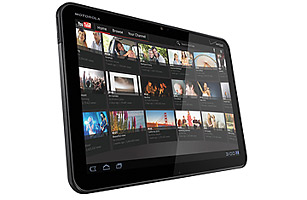
When Steve Jobs strode onstage and unveiled the iPad in January 2010,
he should have ended his presentation by firing a starting pistol. The
news left nearly every other big computer and consumer-electronics maker
racing to get into the tablet market that Jobs’ iPad had suddenly
created.
As it happens, the competition turned out to be a marathon. More than a
year later, we’re still talking about tablets that are huffing and
puffing their way toward the showroom floor. There’s RIM’s BlackBerry
PlayBook, slated to arrive by the end of March. HP’s Web OS-based
TouchPad is due this summer. And dozens of other models are on their
way. The pace has been so plodding that Apple’s second-generation
iPad — which the company is set to announce next week — will apparently beat most other companies’ first-generation models to market. Then there’s Motorola’s Xoom, which goes on sale at Verizon retail
locations on Thursday.
Unlike the current iPad, the Xoom will also be a 4G wireless device,
thanks to Verizon’s zippy LTE network — but not until the second quarter
of this year, according to Motorola. For now, it comes with 3G and the
promise of a free upgrade. That’s one of several telltale signs that it
was rushed out the door. Adobe’s Flash Player software, which will let
Xoom owners get at Flash Web videos and games that don’t work on the
iPad, won’t be ready for a few weeks. And there’s a dormant slot for
MicroSD memory cards that Motorola plans to enable in an upcoming
software update.
Even if the Xoom is a work in progress, it already does many things
well. The tablet is sheathed in a plastic case rather than the iPad’s
aluminum, but it’s pleasing to the eye and touch; slightly thinner than
the iPad, the Xoom tips the scales at an identical 1.6 lb. It also
out-iPads the iPad by doing away with even that tablet’s single physical
button on the front.